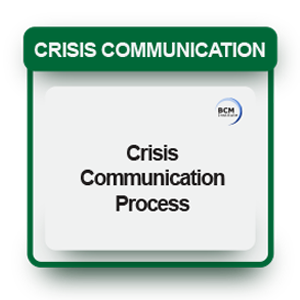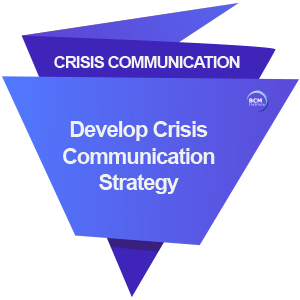 Managing Crisis Communication as Part of the Command Centre Team
Managing Crisis Communication as Part of the Command Centre Team
What is Crisis Communication?

Crisis Communication deals with the reputation of individuals as well as the organization. It is an initiative to protect the organisation's reputation and maintain its public image.
 Various examples of crisis scenarios (situations) (click button on the right), such as criminal attacks, government investigations and media enquiries, can tarnish the image of an organization.
Various examples of crisis scenarios (situations) (click button on the right), such as criminal attacks, government investigations and media enquiries, can tarnish the image of an organization.
Crisis Communication specialists focus on situations that tend to harm the reputation and image of the organization.
Our definition of crisis communications (Swedish Emergency Management Agency (SEMA), 2008) is the information exchanged between public authorities, organizations, the media, affected individuals and groups before, during and after a crisis.
Need for Crisis Communication
Crises can have adverse effects on brand image. Crisis Communication experts protect an organisation’s reputation against threats and unwanted challenges.
Brand identity is one of the most valuable assets of an organization. The primary purpose of the Crisis Communication team is to protect the brand identity and maintain the organization’s firm standing within the industry.
Crisis Communication specialists strive hard to overcome challenging situations and help the organization come out of difficult situations in the best possible and quickest way.
The media largely shape the public’s picture of a crisis. The need for information in a crisis is vast, and mass media are nearly always first and have the most significant impact. A false picture will be difficult to adjust later. This is why communication with the media has to work from the start, and information from public authorities should be as correct and complete as possible.
Communication between the public, the media and public authorities are ultimately based on confidence in democracy. Communication has to flow between these three groups in both directions. Effective crisis communication also includes the capacity to identify different target groups and adapt communication. In the relationship between the public and public authorities, public authorities have to understand the value of communicating with the public in a crisis, be able to gather and use information from the public and provide information.
Crisis communications by and between public authorities require coordination and cooperation between authorities, organizations and businesses, but also the ability to inform and seek information.

Crisis Communication Process
Employees should not ignore any of the external parties and essential clients. Come out, meet them and discuss the problem with them.
There is nothing to be ashamed of. If needed, seek their help. Media must not be ignored. Answer their questions. Avoiding media makes the situation all the worse. Click the button on the right to learn more about the CC process.
Do Not Criticize Individuals
Show care and concern for them. Share their feelings and encourage them not to lose hope. Could you encourage them to deliver their best? Put yourself in their place. Respect them and avoid playing blame games.
Effective Communication Must Be Encouraged at the Workplace During Emergency Situations
Employees should have easy access to their superior’s cabins to discuss critical issues and reach a mutually acceptable solution.
Information Must Flow Across All Departments In Its Desired Form
One should not rely on mere guesses works or assumptions during a crisis. Make sure the information you have is accurate.
Crisis communication specialists must learn to make quick decisions. Remember that one needs to respond quickly and effectively to unstable situations. Think out of the box and devise alternate plans for the smooth functioning of the organization.
Make sure information is kept confidential. Serious action must be taken against employees sharing information and data with external parties. Such things are considered highly unprofessional and unethical and spoil the organisation's reputation.
The superiors must evaluate the performance of employees regularly. Ask for feedback and reports to know what they are up to. Conduct surprise audits to track the performance of employees.
Organizations hire crisis communication specialists to overcome tough times and maintain their reputation and position in the market.
Develop Pre-crisis Communications Requirement
Public relations are the single most crucial element of crisis management. Crisis Communication is used to reduce tension, demonstrate a corporate commitment to correct the problem and take control of the information flow. Crisis communication involves communicating with a variety of interested parties. Excellent communication is the heart of any CM Plan and should:
- Create guidelines for a designated spokesperson covering working with the media and stakeholders;
- Prepare templates for communication within various scenarios; and
- Review media statements and propose answers to protect against privilege waivers and potential admissions that can be used in litigation by the legal team.
The person who handles media contact must understand his or her role - spokesperson or press secretary.
The communicator or primary spokesperson is usually responsible for gathering participants beforehand and deciding how you will respond. He/she should also anticipate any problematic questions and suggest how they should be answered and by whom.
Crisis Communication Strategy
 The strategy can be divided into the categories of crisis developed at the risk identification stage of the CM planning process. For each category of crisis, the strategy includes:
The strategy can be divided into the categories of crisis developed at the risk identification stage of the CM planning process. For each category of crisis, the strategy includes:
- Developing key messages for crisis scenarios.
- Maintaining a holding statement.
- Identifying the target audience, stakeholders, and interested parties.
- Establishing communication channels with stakeholders.
- Identifying third-party endorsements and opponents.
Find out more about Blended Learning CM-300 [BL-CM-3] & CM-5000 [BL-CM-5]
 |
 |
 |
 |
![TMM [BL-CM-5]](https://no-cache.hubspot.com/cta/default/3893111/54680a64-9914-4958-8cec-1bc451ed5053.png) |
![[BL-CM] [5] Register](https://no-cache.hubspot.com/cta/default/3893111/82024308-16f4-4491-98be-818a882c6286.png) |
 |
![Email to Sales Team [BCM Institute]](https://no-cache.hubspot.com/cta/default/3893111/3c53daeb-2836-4843-b0e0-645baee2ab9e.png) Please feel free to send us a note if you have any of these questions. Please feel free to send us a note if you have any of these questions. |
 |
Find out more about Blended Learning CC-5000 [BL-CC-5]
This is another series of specialist training from BCM Institute focusing on crisis communication.
 |
||
![FAQ [BL-CC-5]](https://no-cache.hubspot.com/cta/default/3893111/20839722-3dbc-4dcb-a2bf-9e451632f722.png) |
If you want to continue knowing more about your crisis communication learning journey, click on the button below. |
 |





